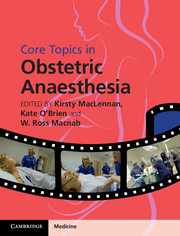Book contents
- Frontmatter
- Contents
- List of contributors
- Preface
- Section 1 Basic science, epidemiology and service organization
- Section 2 Obstetric aspects
- Section 3 Provision of anaesthesia
- Section 4 Medical conditions in pregnancy
- 14 Hypertension in pregnancy, pre-eclampsia and eclampsia
- 15 Sepsis and influenza in pregnancy
- 16 Cardiac disease in pregnancy
- 17 Respiratory disease in pregnancy
- 18 Obesity and ultrasonography for central neuraxial blocks
- 19 Endocrine disease in pregnancy including diabetes mellitus, thyroid and adrenal disease
- 20 Renal disease
- 21 Haematologic disease in pregnancy
- 22 Neurosurgical and neurological disease in pregnancy
- 23 Immunology, including testing and management of allergy during pregnancy
- 24 HIV and infectious disease in pregnancy, including herpes, syphilis and hepatitis
- Section 5 Postpartum complications and obstetric emergencies
- Section 6 Service organization
- Index
- Plate section
- References
15 - Sepsis and influenza in pregnancy
from Section 4 - Medical conditions in pregnancy
Published online by Cambridge University Press: 05 December 2015
- Frontmatter
- Contents
- List of contributors
- Preface
- Section 1 Basic science, epidemiology and service organization
- Section 2 Obstetric aspects
- Section 3 Provision of anaesthesia
- Section 4 Medical conditions in pregnancy
- 14 Hypertension in pregnancy, pre-eclampsia and eclampsia
- 15 Sepsis and influenza in pregnancy
- 16 Cardiac disease in pregnancy
- 17 Respiratory disease in pregnancy
- 18 Obesity and ultrasonography for central neuraxial blocks
- 19 Endocrine disease in pregnancy including diabetes mellitus, thyroid and adrenal disease
- 20 Renal disease
- 21 Haematologic disease in pregnancy
- 22 Neurosurgical and neurological disease in pregnancy
- 23 Immunology, including testing and management of allergy during pregnancy
- 24 HIV and infectious disease in pregnancy, including herpes, syphilis and hepatitis
- Section 5 Postpartum complications and obstetric emergencies
- Section 6 Service organization
- Index
- Plate section
- References
Summary
Sepsis
Introduction
Sepsis is defined as SIRS (systemic inflammatory response syndrome) caused by suspected or proven infection. SIRS is the body's response to an insult. The physiological hallmarks of SIRS are generalized vasodilatation and increased microvascular permeability. These changes can be triggered by both non-infective insults (e.g. burns) and infection. The development and progression of SIRS and sepsis are thought to be due to uncontrolled release of pro-inflammatory mediators and dysregulation of the inflammatory response, leading to widespread tissue injury. Sepsis is a dynamic process and can progress to severe sepsis and septic shock. Despite mortality rates improving over the last 10 years, mortality from septic shock remains high at approximately 24%.
Sepsis in obstetrics
In 2005, the World Health Organization (WHO) reported that infection and sepsis were responsible for 15% of global maternal deaths. In the latest UK Confidential Enquiry into Maternal Deaths sepsis was the leading cause of direct maternal death. Maternal mortality from sepsis has increased almost threefold in the last 25 years.
Sepsis can occur at any time during pregnancy and the puerperium. Sources of infection include both obstetric and non-obstetric causes (Table 15.1). The physiological changes of pregnancy can mask signs of sepsis and provide diagnostic difficulty. In addition, maternal deterioration can rapidly result in fetal compromise. Prompt diagnosis and management are essential. Close liaison between with obstetricians, anaesthetists, microbiologists, physicians and critical care is important to ensure a good outcome for mother and baby.
The general principles of sepsis management discussed below apply to the obstetric patient, but must also take into account the physiological changes of pregnancy and associated conditions (e.g. pre-eclampsia).
Definitions
The following definitions have been developed to improve the ability to diagnose, monitor and treat sepsis:
Infection: the invasion of normally sterile tissue by organisms.
Bacteraemia: the presence of viable bacteria in the blood.
Systemic inflammatory response syndrome (SIRS): the presence of two or more of the following:
• Temperature >38.3 °C or <36 °C
• Heart rate >90 beats/min
• Respiratory rate >20 breaths/min or PaCO2 <4.3 kPa
• WBC >12,000 cells/mm3 or <4000 cells/mm3.
Sepsis: SIRS due to a suspected or proven infection.
Severe sepsis: the combination of sepsis and at least one organ dysfunction (Table 15.2).
Septic shock: severe sepsis plus hypotension (MAP < 60 mmHg or < 80 mmHg if pre-existing hypertension) despite adequate fluid resuscitation (defined as a minimum of 30 mL/kg of crystalloids).
- Type
- Chapter
- Information
- Core Topics in Obstetric Anaesthesia , pp. 105 - 113Publisher: Cambridge University PressPrint publication year: 2015



